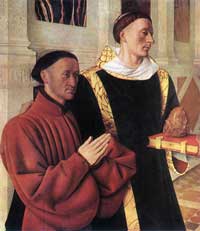French Renaissance: Architecture and Arts
The French architecture and arts reached their Renaissance zenith under Francis I, the king with an artist's mind. To his enthusiasm for building are due Fontainebleau, Chambord and much of the palace at Blois.
A great part of the Châteaux of the Loire were erected by great nobles following his example. They were stately homes and fortresses in one, where cupids and epigrams carved in stone decorate guard-rooms and garde-robes, and politicians were provided with secret chambers for eavesdropping, and courtiers with winding, shell-like stairways.

Jean Fouquet
Estienne Chevalier with St. Stephen
Staatliche Museen, Berlin
The name of Pierre Lescot (1510-1578) is inseparable from the Louvre Palace which he began to reconstruct under Francis' orders; that of the greater Philibert de l'Orme (c.1512 - 1570) from the palace of the Tuileries which he built under Henri II, as well as Diane de Poitiers' home at Anet. De l'Orme recalls the many-sidedness of Italy, and had mastered not only his profession but the arts of writing and of fortification. For the rest, what makes the French Renaissance so distinct and self-contained, is its restrictedness, as the characteristic search after Universality did not tempt the precise and practical French mind.
Jean Goujon (c. 1510-1572) was the very voice of Renaissance in France. Whoever has seen his Fontaine des Innocents, the public fountain which he made for Paris, will know why. The rhythmic figures of his nymphs, bending, curving, floating on aerial draperies, full of watery enchantment, his Glory and his trumpet-blowing Fame on the outer walls of the Louvre, his reclining statue of Diana, all are full of a lyric elegance, of inborn style, and of a kind of spontaneous artificialness.
Michel Colombe, his contemporary, is also essentially French. He also had been to Italy, then had learnt his craft in the Burgundian School of Dijon, the town through which passed all travellers between Italy and France. He sculpted the famous Church of Brou, in the forest of Bourg-en-Bresse, a shrine of married love meant to perpetuate Margaret of Austria's grief for the death of her husband, Duke Philibert of Savoy.
French Schools of painting in the RenaissanceFrom the beginning of the 15th century, the Burgundian school of painting flourished. Under the patronage of the Dukes of Burgundy, also rulers of the Netherlands, it developed in close relations with the Flemish artists, but with a strong touch of French taste. Her saints and Virgins are crisper and more lucid, as they were more epigrammatic than those of Flanders.
Among the painters outside the Flemish influence, the greatest was Jean Fouquet of Tours (1420-1481). He is the exquisite illustrator of "Le Livre d'heures d'Etienne Chevalier," work which contains marvels of narrative picture. He is the author of the famous portraits in the Louvre representing Charles VIII and Guillaume Jouvenel des Ursins, the Chancellor of Charles VII.
The Renaissance portrait-painting proved to be the natural outlet for the French critical insight and accomplished sense of beauty. The brilliant little canvases of Jean Clouet and those of his son, François (1510-1572), with those of Corneille de Lyon and Dumoustier, are invaluable records of their time: princesses with jewelled sleeves, and white-hatted baby Dauphins, against bright green backgrounds, masterly summaries of character and of manners.
Scholars and PoetsIn France, the Renaissance men of learning were born later than the Italians, and perhaps because of that, they went deeper. Foremost among them comes the illustrious Guillaume Budé (Budæus), the Greek scholar and philologist, the counsellor who helped Francis and his sister to found the Collège de France. Then there were Robert and Henri Estienne, father and son, Latinists of universal fame, forcing even their household to speak Latin; or Postel, the Orientalist, who dreamed that Francis might reign as Emperor, uniting East and West; or Amyot, the Greek professor.
Among poets, the first half of the 16th century was the time of Clément Marot (1495- 1544), the successor of François Villon (1431- after 1463), and of Charles d'Orléans (1394- 1465). During the Renaissance, nowhere else were the poets, scholars, and artists more honoured than at the Court of France. Louis XI, Charles VIII, Louis XII, Francis I were their protectors. Even more, they had a nobler guardian, Francis' sister, Marguerite D'Angoulême, Queen of Navarre, a literary spirit, and a poet herself.
She did not live to see the work of the great French poets of her century. It was for Marguerite de Savoie, her niece, to be the patron of the Pléiade, the Renaissance group of seven poets who laid down the lines of the revival of the French language. They were led by Pierre de Ronsard (1524-1585) and by Joachim Du Bellay (c. 1522-1560).
The Pléiade manifesto was published in 1550, in the shape of Du Bellay's Illustration de la langue française. But the literary world did not welcome their ideas, and the old school poets rose against them. It was not till Marguerite de Savoie took them under her protection that their reputation was established.
The French Renaissance poets, and the Pléiade, will be discussed in more detail in a separate page.